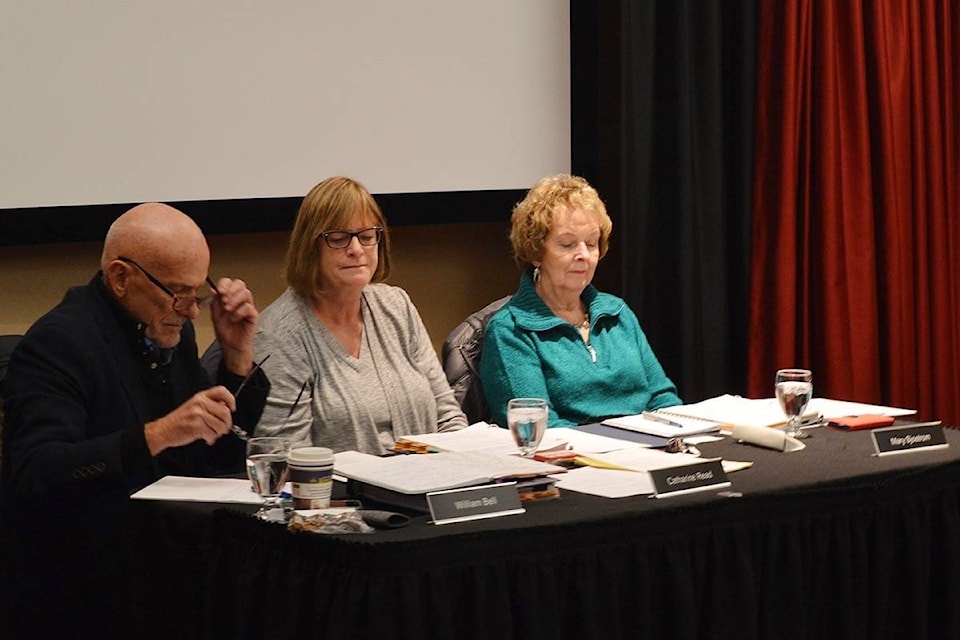Leaders from across Northern B.C. presented a united front opposing Greyhound’s requested withdraw from Hwy16 at the recent public hearing in Terrace today.
Put on by the Passenger Transportation Board, the meeting drew close to 20 people, and included a presentation from Greyhound managers to answer questions about their operations and proposed pullout of northern routes.
Seven elected officials took the podium to express their concerns, including Terrace mayor Carole Leclerc, Deklan Corstanje from the Regional District of Kitimat-Stikine, Ethan Anderson from the District of Kitimat, Franciose Godet on behalf of MP Nathan Cullen, Cal Albright from the Terrace Kermode Friendship Centre, as well as two residents, Heather Sones from Prince Rupert and Myrna Stephens from Terrace.
Together they urged the board to turn down Greyhound’s request to withdraw, saying the service is too important to the area.
The subsidized BC Transit service was made to compliment Greyhound’s service, said several of the speakers, noting that the new subsidized transit isn’t meant for longer distance travel.
READ MORE: Terrace to Kitimat bus service launched
Besides that, transportation is fairly limited, with flights typically more expensive and Via Rail inconsistent, they said, singling out several effects of the service, including safety on the Highway of Tears, transportation between the spaced out communities, and economic and business prosperity, speakers said.
Several residents also emphasized a huge thank you to Greyhound, saying they have provided strong, consistent service that has been greatly valued for many years.
Stuart Kendrick, senior vice president of Greyhound Canada, also gave a presentation reiterating Greyhound’s challenges, and making a call for the province to create a comprehensive “Connecting Communities Fund” to subsidize transportation in the north.
READ MORE: Greyhound calls for public-transportation fund
“It’s not what we want,” said Kendrick. “Greyhound recognizes that the proposed route reductions will be difficult for affected passengers and communities,” but the business is simply not viable, he said.
He went on to address a number of questions posed by the board and by the public at the meeting.
“Why the overnight schedule?” asked one resident, referring to the daily northbound route which leaves Prince George at 9:30 p.m. and arrives in Terrace at 6 a.m.
Kendrick said it’s because the company’s revenue is mainly coming from its parcel service, so it catered its scheduling around the parcels, which ideally arrive in the morning.
“Most of our revenue comes from the freight business, so we’ve had to adjust our schedule to meet really, the most of the revenue,” said Kendrick of the reality of doing business.
“The freight business is more of an overnight, morning delivery,” he said, adding that with the big miles they have to cover in B.C., it’s hard to service everyone in the daytime.
“But most of the answer to your question is related to the freight business,” he said. “The night time trip is the most ideal for what we are trying to do now.”
Another resident suggested reducing frequency to save costs.
Though Kendrick didn’t directly speak to the question, he did say the company has reduced services several times over the years, but it remains un-viable.
“This has been a declining trend for many years, but it’s not one that we haven’t communicated to the provincial and federal government on a regular basis,” he said. “We’ve presented many solutions to address the issue, and what you’re seeing now is ridership [averaging single digits] on all of the routes we’ve asked to discontinue.
READ MORE: Greyhound could soon depart Northern B.C.
“A private carrier that has to rely on the fare box alone, [we] can’t sustain the losses anymore,” he said.
The idea was also posed that they could use smaller buses to reduce costs.
But Kendrick said short buses don’t last as long, are less suitable for Canadian winter roads, and have only 24 seats — no washrooms or luggage storage ideal for the longer northern routes.
He added that Greyhound does operate short buses in the rural United States, but it’s subsidized by U.S. federal grants as a rural connector program.
After the presentations, and a few closing remarks from Greyhound, the passenger board thanked residents for their input, saying the board will make its decision in early-2018.
CLICK HERE to view Greyhound’s request to the Passenger Board, or their slideshow presentation
